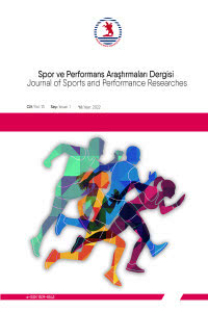THE ASSOCIATION BETWEEN BASKETBALL PLAYERS’ TIMES IN THE GAME AND THEIR PERFORMANCE: A COMPARISON OF EUROLEAGUE-EUROBASKET
Basketbol, Eurobasket, Euroleague, Performans analizi.
THE ASSOCIATION BETWEEN BASKETBALL PLAYERS’ TIMES IN THE GAME AND THEIR PERFORMANCE: A COMPARISON OF EUROLEAGUE-EUROBASKET
Basketball, Eurobasket, Euroleague, Performance analysis,
___
- 1. Karipidis A, Fotinakis P, Taxildaris K, Fatouros J. Factors characterizing a successful performance in basketball. Journal of Human Movement Studies, 2001;41(5):385-397.
- 2. www.euroleague.net, www.eurobasket.com; Access dates:10-25.11.2018.
- 3. National Basketball Association [homepage on the Internet]. Available from: http://www.nba.com/, Access dates:10-25.11.2018.
- 4. Utku Özmen M. Marginal contribution of game statistics to probability of winning at different levels of competition in basketball: Evidence from the Euroleague. International Journal of Sports Science and Coaching, 201;11: 98-107.
- 5. Sampaio J, Janeira M. Statistical analyses of basketball team performance: Understanding teams' wins and losses according to a different index of ball possessions. International Journal of Performance Analysis in Sport, 2003;3(1):40-49.
- 6. Ribas RL, Navarro R, Tavares F, Gómez MA. Analysis of number of players involved in rebound situations in Euroleague basketball games. Open Sports Sciences Journal, 2011;10-13.
- 7. Işık T, Gençer RT. Basketbolda takım performansının teknik analizi: iç saha ve dış saha performanslarının değerlendirilmesi. Spor Bilimleri Dergisi, 2010:18(3);101-108.
- 8. Leonard WM. A Sociological Perspective of Sport. London: Allyn and Bacon, 1998.
- 9. Kozar B, Vaughn RE, Whitfield KE, Lord RH, Dye B. Importance of free-throws at various stages of basketball games. Perceptual and Motor Skills, 1994;78(1), 243-248.
- 10. Drust B. Performance analysis research: meeting the challenge. J Sports Sci. 2010;28(9):921-922.
- 11. Hughes MD, Bartlett R. The use of performance indicators in performance analysis. Journal of Sports Sciences, 2002;20, 739 – 754.
- 12. Nevill A, Atkinson G, Hughes M. Twenty-five years of sport performance research in the Journal of Sports Sciences. J Sports Sci. 2008;15;26(4):413-26.
- 13. Paulauskas R, Masiulis N, Vaquera A, Figueira BE, Sampaio J. Basketball game-related statistics that discriminate between European players competing in the NBA and in the Euroleague. Journal of Human Kinetics, February, 2018.
- 14. Suárez-Cadenas E, Courel-Ibáñez J. Shooting strategies and effectiveness after offensive rebound and its impact on game result in Euroleague basketball teams. Cuadernos de Psicología del Deporte, 2017;17:3, 217-222.
- ISSN: 1309-5110
- Yayın Aralığı: 3
- Başlangıç: 2010
- Yayıncı: Ondokuz Mayıs Üniversitesi Yaşar Doğu Spor Bilimleri Fakültesi
SPOR YAPAN VE YAPMAYAN LİSE ÖĞRENCİLERİNİN SOSYAL BECERİ DÜZEYLERİNİN İNCELENMESİ: ISPARTA ÖRNEĞİ
Mehmet Emin KOCA, Olcay SALİCİ
SPOR ETKİNLİKLERİNE YÖNELİM ÖLÇEĞİNİN TÜRKÇE GEÇERLİK VE GÜVENİRLİK ÇALIŞMASI
Hüseyin ÇEVİK, Kerem Yıldırım ŞİMŞEK, Anıl Onur MERCANOĞLU, Alican BAYRAM
GÖRME ENGELLİ FUTBOL VE FUTSALCILARIN MÜSABAKA ÖNCESİ DURUMLUK KAYGI DÜZEYLERİNİN İNCELENMESİ
Mehmet YAZICI, Recep ÖZ, Yasemin ÇAKMAK YILDIZHAN, Harun BÜYÜKYILDIRIM
8-10 YAŞ GRUBU YÜZÜCÜLERİN 25M FARKLI STİL YÜZME PERFORMANSLARININ MOTORİK ÖZELLİKLER İLE İLİŞKİSİ
Benil KISTAK, Çiğdem BULGAN, Bergün Meriç BİNGÜL, Mustafa Arslan BAŞAR
Yasin ARSLAN, Gülfem SEZEN BALÇIKANLI
Egemen ERMİŞ, Erkan KONCA, Necati Alp ERİLLİ, Aydan ERMİŞ
Egemen ERMİŞ, Aydan ERMİŞ, Necati Alp ERİLLİ, Erkan KONCA
ELİT VOLEYBOLCULARDA SERVİS ÇEŞİDİ, POZİSYON VE CİNSİYETİN SERVİS HIZINA ETKİSİ
Özge ÇINAR MEDENİ, Cengiz AKARÇEŞME, Şenay ÇEREZCİ, Nihan ÖZÜNLÜ PEKYAVAŞ, Fatma Filiz ÇOLAKOĞLU, Gül BALTACI
